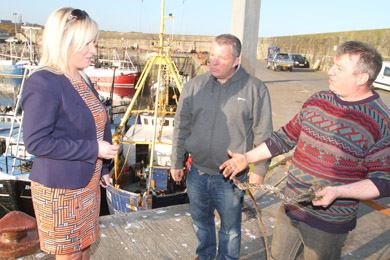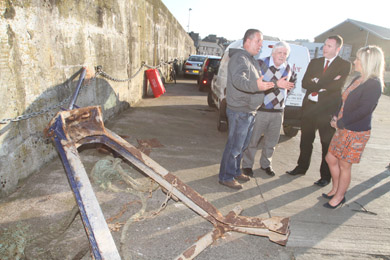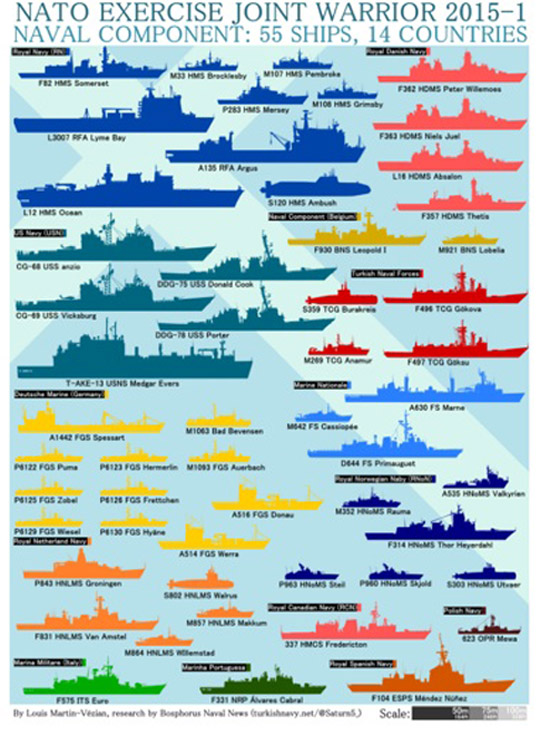The incident involving the near sinking of the Karen, a 60-feet Ardglass prawn trawler has gone global.
Tomorrow (Tuesday 21st April) a crew from the New York Times will be in Ardglass to interview the skipper Paul Murphy as this encounter grips the imagination from Honolulu to Hollywood (County Down).
[caption id="attachment_56104" align="alignleft" width="390"] NI Fisheries MInister Michelle O’Neill at Ardglass harbour talking to Karen skipper Paul Murphy and owner Simon Wills as they examine the wire ropes snapped by a submarine.[/caption]
NI Fisheries MInister Michelle O’Neill at Ardglass harbour talking to Karen skipper Paul Murphy and owner Simon Wills as they examine the wire ropes snapped by a submarine.[/caption]
Down News broke the first full account of this near tragedy and skipper Paul Murphy, who has experienced a tsunami of emotions from his near-death experience, said: “I will not rest until I get some reasonable answers as to what happened. My crew who almost lost their lives have that right.
“The Karen has been well shaken up. We lost our fishing gear, our wire ropes, the galluses are wrecked, the deck is torn up, and the winch is also damaged. We are well into repairing the damage but overall I think it must all come to around £50,000 in total. We just don’t need this.”
The Karen had made her second tow about 12 miles off the coast of County Down, and was steaming around two knots towing north-west with her prawn net on the bottom. Suddenly the vessel stalled and lurched. Then it started to move backwards rapidly accelerating to 10 knots which is just over its top speed of 8 knots going forward. There were two steel wires connected to the net. As the Karen plunged rapidly backwards, the quick thinking crew released one set of wires from the winch which fed out, but another set coiled up and snagged causing the vessel to be dragged sideways to the starboard side.
As a result, the Karen was dragged backwards and sideways, the crew were soon up to their wastes in seawater as the vessel rapidly was being rolled over to the point it would capsize. Fortunately the second wire rope snapped and released the Karen from a watery grave. Skipper Paul Murphy said: “We were literally seconds from death. It was terrifying.”
O’Neill Calls For Clarity Over Submarine Incident
Fisheries Minister Michelle O’Neill has called on the British Ministry of Defence (MoD) to clarify any involvement in last week’s incident in which an Ardglass trawler was snagged by a submarine 15 miles off the County Down coast.
[caption id="attachment_56106" align="alignright" width="390"] Skipper Paul Murphy, NIFPO chief executive Dick James, Chris Hazzard MLA, and Fisheries Minister Michelle O’Neill look over part of a steel support ripped off the deck of the Karen as the submarine snagged the wires to its net.[/caption]
Skipper Paul Murphy, NIFPO chief executive Dick James, Chris Hazzard MLA, and Fisheries Minister Michelle O’Neill look over part of a steel support ripped off the deck of the Karen as the submarine snagged the wires to its net.[/caption]
The Minister was speaking as she met with Mr Simon Wills, owner of the trawler, the ‘Karen’, and skipper Paul Murphy at Ardglass harbour where she inspected the damage caused to the trawler after its nets were snagged by a submarine in the Irish Sea.
She said: “I am deeply concerned about last week’s incident in which this trawler was dragged backwards when fishing nets were snagged by a submarine, putting lives at risk. Safety at sea is paramount for the fishing industry and our fishermen must not be exposed to these sorts of incidents.
“I have written to British Secretary of State Elizabeth Truss to raise my concerns and I have requested an investigation and a full report as to the circumstances that led to the lives of local fishermen being put severely at risk. It is only for the quick reactions of the crew that there were no fatalities.
“There are clear guidelines that must be adhered to in incidents such as this, however, in the case of the Karen those guidelines appear to have been flouted. Our fishermen have the right to know if a British, NATO or Allied submarine was involved or not.
“We need to put pressure on this matter now before lives are lost. The fishermen of County Down have my full support.”
NIFPO Chief Says Safety Protocols Should Have Been Observed By Submarine
[caption id="attachment_56103" align="alignleft" width="390"] A rough comparison of the size of a nuclear submarine and the Karen.[/caption]
A rough comparison of the size of a nuclear submarine and the Karen.[/caption]
Dick James NIFPO chief executive has liaised with Minister O’Neil through this incident and explained: “There are clear protocols set up and this submarine, if it was a Royal Navy one, Allied or NATO, should have surfaced. In fact there is a daily radio broadcast telling mariners what submarine activity is taking place around our coast which was established years ago as part of these safety measures.
“These submarines have plenty of sensors around their hull to let them know when they snag up with a trawler. So far my appeals for information from the MoD have not provided much in the way of progress.It is very slow.”
Boat Owner Angry At Lack Of Transparency Over Submarine Activity
Boat owner Simon Wills said that this was an accident that should not have happened. He added: “I just cannot understand with all the sophisticated gear on a modern submarine that it cannot work out the track of the trawlers and where their fishing gear is. Quite simply they should not be there.
“If it is an absolute matter of national security that they run exercises in our fishing waters we should be at least notified and at best compensated if we have to tie up and let them get on with it. In fact many of us would be happy enough to do this if we were reasonably compensated. But this is not about money. It is about the survival of fishermen at sea. It is just a good job it was not dark when this happened. My four-man crew were seconds from going into the water and possibly dying.”
“Thankfully the crew were safe after this incident but it could easily have been a different story. This affects all the fishermen in the Irish Sea and beyond.
“I am grateful for Fisheries Minister O’Neill showing her support for the fishermen and I hope that we can find a solution to this problem.”
Celtic League Lobbies For End To Submarine Activity Near Fishing Vessels
The Celtic League was formed was formed over fifty years ago (1961) and has a broad campaign remit on a range of issues. It started monitoring military activity via its Manx branch in the late 1970’s and then extended this to the waters of the whole League (all six Celtic countries) in the early 1980’s. Serious monitoring of sub activity started in 1983 (one year after the Sheralga incident) when the Cite D’Aleth was lost off Wexford and the League realised they had a major problem on their hands.
[caption id="attachment_56108" align="alignright" width="340"] Bernard Moffat of the Celtic League.[/caption]
Bernard Moffat of the Celtic League.[/caption]
Spokesperson Bernard Moffat said: “There have been countless incidents at sea between submarines and fishing boats on the western seas off the UK. For example, the incident with the Sheralga (1984) shows how callous submariners can be. And additionally although the Royal Navy owned up over the Antares deaths (1992) on the Clyde the submarine did not surface for sometime after the incident when it was clear it would be ‘in the frame’.
“We initially put great effort into monitoring this and only wound it down when it looked as if the threat had markedly diminished. When we met for our AGM in Dublin recently I remarked that we may need to ramp it up again.
“It appears now that the threat to life and limb of fisheremen is back with a vengeance. a few years ago we had the loss of the Breton trawler Bugaled Breizh off the Lizard during a Nato exercise and all hands perished.
“The size of vessel is no help either. The Cite D’Aleth lost in 1983 off Wexford and which really spurred our campaign was a large Motor Fishing Vessel with a crew of a dozen and all were lost). It got out a mayday to say it was being capsized, but unfortunately the rescue effort after that appears to have been botched. There really is no contest when a submarine of between 5000-7500 tonnes underwater meets a fishing boat of 50-150 tonnes on the surface.
[caption id="attachment_56109" align="alignleft" width="390"] The Karen docken against the wall at the quayside in Ardglass harbour.[/caption]
The Karen docken against the wall at the quayside in Ardglass harbour.[/caption]
“Nor is there any area of the Irish sea which is immune from risk. Local fishermen here lampooned our suggestion that the waters to the east of the Isle of Man (comparatively shallow) would be an area of possible risk (even though there was an admiralty chart showing the area between IOM and Liverpool Bay as a submarine exercise area.
Then the USBN Nathaniel Greene lost its prop in the area (8000 tonnes no small sub!) and people took it seriously. A year or so later the same sub struck the seabed travelling at speed just about 20 miles south of the IOM there are suggestions the pollution from the incident is still there – it was so badly damaged it was eventually taken via Faslane to the US and decommissioned.
“Several boats (MFVs) were lost inexplicably in that East Irish Sea area. The Mhari L, The South Stack (she just disappeared) and the Belgian vessel Tilj Uileanspiegel. All the same scenario very experienced fishermen, sound vessels, very good weather, a flat calm in the case of the Mhari L) and no mayday, with little or no debris.
“Earlier this year, I pressed all the European and US sub operating powers about compliance with IMO 709.17. So far results have been disappointing. Only the German government has responded positively although the MOD say the correspondence to them is in hand.
“Then, the recent incident involving a Motor Fishing Vessel and a Submarine of the west coast of the Isle of Man reminds us that sadly a problem that fishermen knew only to well in the 1980’s is back to haunt coastal communities.
“The Celtic League monitored this and other military activity and thanks to a contributor to the sometimes (in terms of the Celtic League) acerbic Manx Forums a media programme link has surfaced which illustrates our role:
www.youtube.com/watch?v=4P_dMuAR-D8″ https://www.youtube.com/watch?v=4P_dMuAR-D8
“It is a programme made in the early 1980’s (I think for BBC Spotlight a Northern Ireland) for a current affairs magazine programme and it features (approx. 10 mins into the 30 min item) an interview with me when I was then General Secretary of the Celtic League).
“It also features the photograph (one of three) taken by my late wife Deirdre of HMS Porpoise just hours before it sank the Irish MFV Sheralga which proved conclusively that a Royal Navy submarine was operating in the Irish sea. The photographs subsequently travelled extensively even ‘surfacing’ in a Japanese newspaper and there most recent airing was about seven years ago in a major documentary for French TV Channels FR3 and TV Monde.
“Contrary to what some pundits are saying today about the behaviour of the Royal Navy in such situations HMS Porpoise did not surface to rescue the Sheralga crew who were only saved when another fishing vessel came upon them by chance in the water. Indeed the MoD kept on denying the incident until the photographic evidence proved otherwise.
“Despite much speculation today about the possible latest culprit being Russian most recorded incidents including the fatal loss of the Antares are down to British or United States submarines. Certainly during the Cold War the soviets used so called AGI’s (Auxiliaries Gathering Intelligence) converted trawlers bristling with aerials and sporting state of the art sonar. Such vessels were often seen in waters off the west and east of the Isle of Man, the Clyde approaches and the Pembroke Strait.
“The Faslane Celtic League group were also able to alert us when there seemed to be ‘a panic’ on at the base – as in 1986 when they advised us in advance of an incident in the Irish sea involving the USBN Nathanial Greene which struck the seabed south east of the Isle of Man and was so badly damaged it had to be decommissioned.
“By 1990 we had also succeeded in getting the International Maritime Organisation to act using the good Offices of many MP’s and TD’s and demonstrated widespread political support.
“By the mid 1990’s with the end of the Cold War activity levels declined and we wound down our monitoring. One of the last acts undertaken in that phase was to lay a wreath with the names of a number of MFV’s lost in suspicious circumstances in the sea about eight miles South of the Chickens Rock near the Isle of Man. Celtic League member Mark Kermode undertook this job and in addition to laying the wreath recited the Lords Prayer in Manx.
“We thought the number of these incidents had peaked and gone into decline but with the loss with all hands of the Breton trawler Bugaled Breizh some years (also during a NATO exercise) ago the incidents started again and this year there have been at least two recorded.
The Russians – Are They A Useful Scapegoat?
Bernard Moffat, spokesperson for the Celtic League said: “The jury is still out on the submarine incident with the Karen but we think it’s more than likely the Royal Navy are in the frame.
“Speculation without any basis in fact at all is that a Russian submarine may have been responsible for the snagging of a trawler from Ardglass.
“The simplistic view is that a NATO submarine would surface on entangling itself in the nets of a Motor Fishing Vessel. However the facts do not bear this out. We have highlighted in previous news posts the fate of the crew of the Sheralga left to drown after being towed under by HMS Porpoise (fortunately they were rescued).
“More interesting was the fate of the Summer Morn (another Northern Ireland vessel) was dragged backwards for almost three hours in 1987 with the submarine stopping periodically and then surging forward trying to break free from the net. The rather stubborn skipper refused to cut his gear and eventually by which time TV crews in chartered helicopters were overhead and the US submarine surfaced and the gear was freed.
“Nuclear submarines are very large and a very fast attack submarine is over 360 ft long and 33 ft wide. A ballistic missile submarine can be 560 ft (length of two football pitches and 45 ft wide. They can travel at 25 knots submerged and the newer attack submarines in excess of 30 knots.
“Collision danger may be enhanced because all nuclear submarines have trailed array systems for communications or sonar. The two vessels submarine and MFV could be over a mile and a half from each other and still be hooked.
“So who was it? Well leaving aside the added complication of the on-going NATO exercise the area to the west of the Isle of Man is a submarine exercise area.
“For many years the Celtic League had some ‘pricey’ charts purchased from the Naval Hydrographers Office and these showed sub exercise areas all round the UK.
“Area 81 (or to give its accurate designation Peel X5403) runs down the west coast of Mann from the North Channel to about 12 miles south of the Chicken Rock.
“Area 80 (or to give its accurate designation Peel X5402) runs down the east coast of Ireland from the North Channel to Carlingford Lough.
“In addition British nuclear submarines use the natural deep water trench down the east coast of Ireland (from the Beaufort Dyke to the Celtic Sea where it broadens out). The reason for this is the Irish Sea which is comparatively confined is noisy. Shipping movements, fishing gas field’s natural seismic noise bouncing of the coast lines is the perfect environment for a submariner who wants to loose himself from any potential shadowing predator from the opposition.”
Therefore, according to Bernard Moffat, the Royal Navy and its associates may well be responsible for the near sinking of the Karen and are prime suspects.
But in the final analysis, the jury is still out as the hard evidence is too thin to call this decision at this stage.
Related articles: http://www.downnews.co.uk/ritchie-and-hazzard-call-for-action-over-ardglass-trawler-that-netted-a-submarine/ http://www.downnews.co.uk/ritchie-and-hazzard-call-for-action-over-ardglass-trawler-that-netted-a-submarine/ http://www.thejournal.ie/shelga-state-papers-1984-1837788-Jan2015/ http://www.independent.co.uk/news/uk/submarine-crew-blamed-for-sinking-of-antares-1532324.html [caption id="attachment_56098" align="aligncenter" width="540"] Ships on the multi-national 2014-15 naval exercise on the western seaboard of Britain.[/caption]]]>
Ships on the multi-national 2014-15 naval exercise on the western seaboard of Britain.[/caption]]]>
























